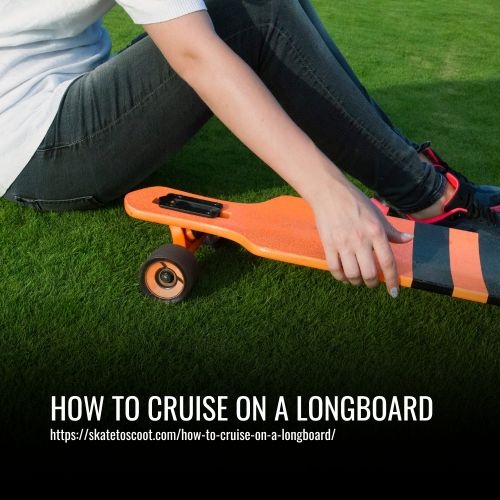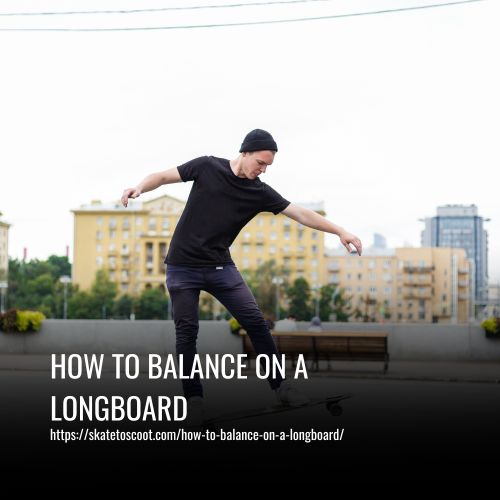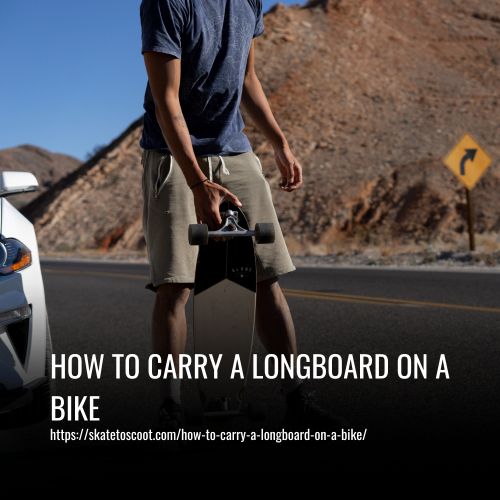As an Amazon Associate we earn from qualifying purchases.
Are you ready to experience the thrill of cruising on a longboard? Whether you’re a beginner or someone who has always wanted to try it, longboarding is a fantastic way to have fun and stay active. With the right techniques and a little practice, you’ll be gliding smoothly along the streets in no time.
Longboarding is not only a great way to get around, but it also offers a unique sense of freedom and exhilaration. Imagine the wind in your hair, the sound of wheels rolling on pavement, and the feeling of effortlessly carving through turns. If this sounds like a dream come true, then keep reading to learn how to cruise on a longboard.

How to Cruise on a Longboard
Cruising on a longboard is an easy and enjoyable activity that requires minimal effort. To cruise, start by selecting a board that fits your style and riding ability. Beginners should opt for a wider, more stable, and slower-rolling setup with softer wheels. Once you have the right board, follow these steps to begin cruising:
1. Choose the Right Longboard:
- Look for a longboard specifically designed for cruising.
- Opt for a board that is around 40 inches in length and 7-8 inches in width for optimal cruising comfort and stability.
2. Determine Your Stance:
- Figure out whether you ride regularly (left foot forward) or goofy (right foot forward).
- Place your front foot on the board accordingly, ensuring a comfortable and balanced stance.
3. Proper Foot Placement:
- Position your front foot in a way that allows you to maintain momentum and control.
- Make sure your longboard has grip tape to enhance stability and prevent slipping.
4. Push Off and Start Riding:
- Give a gentle push with your back foot to start the ride.
- Gradually increase the force of each push to gain speed.
5. Maintain Speed:
- Continuously push with your back foot on flat or thick surfaces to keep the ride going.
- The distance you cover while cruising depends on the strength of your pushes and the terrain.
6. Increase Speed and Distance:
- To go faster and cover more distance, place both hands at the back of the board and slightly bend your back.
- Regularly clean your longboard’s grip tape and wheels for smoother rides.
Etiquette of Longboarding Cruising
When it comes to longboarding cruising, it is crucial to prioritize safety and be aware of your surroundings at all times. This means staying vigilant and taking into account factors such as other longboarders, pedestrians, cars, traffic rules, gravel, curbs, and anything else that could potentially result in an accident. Remember to always stay on the correct side of the street or path when there is traffic present.
Longboarders typically travel faster than pedestrians but slower than cars and bikes, making it important to stay mindful of others around you. Unlike some other modes of transportation, longboards do not have brakes, so stopping takes considerably more effort compared to walking or biking. It’s essential to anticipate the need to stop ahead of time to avoid any potential collisions.
Another crucial aspect of longboarding etiquette is being considerate of other people’s expectations. Since longboarders can change direction or speed quickly, it is often challenging for others to anticipate their movements. Taking this into account, always strive to make your intentions clear and avoid sudden surprises for those around you.
Longboard Cruising – Cruising Definition
Longboard cruising refers to the act of riding a longboard freely and smoothly on smooth tracks. It is considered the most accessible and beginner-friendly style of longboarding. Cruising allows riders to roam at a leisurely pace, enjoying the fresh air and the freedom of gliding on a longboard.
Cruising is not only popular among beginners but also favored by experienced riders looking to relax, warm up, or try out new longboards. It provides a great opportunity for riders to familiarize themselves with different board styles and get a better understanding of their preferences.
While cruising is comparatively easier to learn than other longboarding styles such as downhill riding, freestyle, commuting, and carving, it is still important for beginners to learn some basics. This includes maintaining balance, proper foot positioning, and getting comfortable with turning and maneuvering the board
Tips for Cruising on a Longboard
Cruising on a longboard can be a thrilling and enjoyable experience. Whether you’re a beginner or an experienced rider, these tips will help you make the most out of your cruising sessions.
Choosing the Right Longboard
- Look for a longboard specifically designed for cruising.
- Opt for a board that is around 35-40 inches in length and has a top-mounted deck for better movement.
Loosen the Longboard Trucks
- Use a skate tool to loosen up the trucks before cruising.
- Looser trucks allow the longboard to move freely on flat tracks, enhancing the cruising experience.
Proper Foot Placement
- Determine your dominant foot and place it in front of the longboard deck.
- Having your best foot in front makes it easier to turn and handle the longboard.
Bushings Quality
- Soft longboard bushings provide better control and a smoother ride.
- Consider using softer bushings for a more comfortable cruising experience.
Practice Simple Cruising
- Stick to the basics of cruising when starting out.
- Practice on flat tracks, skating fields, and urban streets to improve your skills gradually.
Wear Comfortable Outfit
- Choose a comfortable and lightweight outfit for a more enjoyable ride.
- Avoid heavy and bulky costumes that may cause discomfort and sweating.
Speed Control
- Control your speed by using your body to handle the longboard.
- Carving can help slow down, while gentle pushing can help increase speed during cruising.
Wear Safety Equipment
- Always wear proper safety gear, including helmets, knee pads, gloves, and appropriate shoes.
- Safety should never be compromised, especially for beginners.
Stick to One Cruising Style
- Focus on mastering one cruising style before attempting others.
- Once you have a firm grasp of one style, you can explore new techniques and maneuvers.
Find a Suitable Spot for Cruising:
- Start cruising in isolated areas with no people or traffic as a beginner.
- As your skills progress, gradually move to slightly busier areas to gain more experience.
Remember, practice and patience are key to becoming a skilled longboard cruiser. Always prioritize safety and enjoy the thrill of cruising on your longboard.
Types of Cruising on a Longboard
Cruising on a longboard can be an enjoyable and exhilarating experience. There are three standard cruising techniques that all enthusiasts should learn: long-distance cruising, boardwalk cruising, and urban cruising.
- Long-Distance Cruising: Long-distance cruising, also known as commuting, involves traveling a significant distance on your longboard. When choosing a longboard for long-distance cruising, it is important to consider portability and ease of handling. Look for a durable and affordable longboard that is lightweight and easy to maneuver. This type of longboard is suitable for multiple riding styles and will enhance your commuting experience.
- Boardwalk Cruising: Boardwalk cruising is a leisurely style of cruising typically done on the beach or in a skating park. It allows you to relax, enjoy the scenery, and get some exercise. When cruising on the boardwalk, it is important to learn how to brake with your foot and practice mellow pushing. Pintail longboards are recommended for boardwalk cruising, as they have larger decks (up to 40 inches) that provide ample space for a comfortable stance. With bigger and softer wheels, pintail longboards offer the ultimate boardwalk cruising experience.
- Urban Cruising: Urban cruising involves navigating through busy streets and shopping markets. This type of cruising requires some experience and skills in handling the longboard in traffic. Before attempting city cruising, it is important to learn regular pushes with responsive turning, and how to deal with bumps and sudden braking. For urban cruising, opt for an agile longboard that can start, stop, and turn quickly. Longboards with smaller lengths (32-36 inches) are recommended for city cruising as they offer better maneuverability and portability.
Boardwalk Cruising: Enjoy a Relaxing Ride Along the Beach or Park
Boardwalk cruising is a leisure style of longboarding that allows riders to enjoy a relaxed and pleasant environment, such as a beach or park. It is a great choice for those who want to unwind, enjoy the scenery, and get some light exercise. Here are some key points to keep in mind when it comes to boardwalk cruising:
1. Ideal Longboard Type:
For boardwalk cruising, it is recommended to choose a longboard with a deck that is 40 inches or longer. This size provides stability and ample space to stand comfortably. Look for a board with a flat deck without concave, as it offers moderate flex. This flex ensures comfortable rides and less stress on your joints. Additionally, invest in large and soft wheels, as they provide a great suspension feel.
2. Techniques for Boardwalk Cruising:
- Foot Braking: When cruising on the boardwalk, one of the essential techniques to learn is foot braking. This method allows you to naturally brake at slow speeds by dragging the sole of your foot on the ground. Practice this technique to ensure you can come to a controlled stop while cruising.
- Mellow Pushing: Cruising on a longboard requires a relaxed and smooth pushing technique. To cruise on the boardwalk, use a mellow pushing technique that allows for a comfortable and enjoyable ride. Lean slightly forward to balance your body weight on your front leg and drop your back foot to the ground to push the board.
- Leaning for Wide Turns: Most big pintail longboards have more lean than turn. This means that pressing on the rails won’t cause your board to turn a lot. When cruising on the boardwalk, you can take advantage of this by leaning a bit before turning. This technique allows for wider turns and a more laid-back cruising experience.
Long-distance Cruising Style
Long-distance cruising is a style of longboarding that involves commuting over longer distances, whether it’s across campus or across town. The goal is to ride faster with less effort, making it ideal for getting from one place to another efficiently. Here’s what you need to know about long-distance cruising:
- Choose the Right Board: For long-distance cruising, opt for a longboard with a deck that is longer than 42 inches. This size allows for easy and comfortable pushing with less effort. Look for a board with a drop platform or double drop design, as they provide excellent stability and a lower center of gravity. These boards are push-friendly and ensure a safe and comfortable ride. Invest in large wheels (around 70-75mm) for speed and soft wheels for shock absorption on uneven surfaces.
- Master the Techniques: To succeed at long-distance cruising, you need to find a sustainable and comfortable riding position. Stand close to the nose of the board and put most of your weight forward. This position allows for better balance and control of speed. Practice power-pushing by balancing on the board with your front foot at a slight angle or forward. Keep your front knee bent to lower your center of gravity and maintain stability while kicking the ground with your rear foot.
Urban Cruising Style: How to Cruise on a Longboard in the City
Urban cruising is all about exploring the city streets on a longboard, maneuvering through traffic, and enjoying the urban landscape. To excel at this style of longboarding, you need a board that is agile and nimble. Here are some tips to help you cruise through the city streets with ease:
- Choose the right board: For urban cruising, opt for a short longboard with a length between 32″ to 38″. This site provides excellent portability and allows you to quickly navigate through crowded areas. Look for a board with a tight turning radius and a stiffer deck for better leverage in turns. A kicktail design can help you easily pass over small obstacles and curbs, but make sure you have good riding skills for stability.
- Master the techniques: Urban cruising requires constant adjustment of your posture, balance, and body weight to navigate through the obstacles in the city. Keep your body in tension and your knees flexed to make quick turns and tail kick. Practice continuous pushing to maintain momentum and learn instant foot braking for quick stops. Remember to ride slowly in crowded areas, use your hands to signal when on a sidewalk, and give space to pedestrians.
- Be aware of your surroundings: When cruising the city, always stay attentive to your surroundings. Be prepared for small and large obstacles and be in the can-do mood to maneuver through anything. Stay in your lane, leave space for pedestrians, and observe traffic rules for a safe ride.
- Develop your skills: To enjoy urban cruising to the fullest, work on improving your skills. Practice quick turning, continuous pushing, and small jumps to overcome obstacles. Use your back foot to lightly kick the board tail over bumps and pebbles. The more you practice, the more comfortable and confident you will become in navigating the city streets on your longboard.
Urban cruising style allows you to explore your city in a fun and unique way. With the right board and the right techniques, you can enjoy a thrilling and exhilarating longboarding experience on the streets of your urban playground. Stay safe, have fun, and enjoy the ride!
The Flat Ground Carving Style
The flat ground carving style of longboarding is a unique form of cruising that allows riders to make successive turns and generate momentum through powerful weight shifts. Unlike traditional cruising where riders use their feet to push, flat ground carving relies solely on the rider’s ability to shift their weight and maneuver the board with fluid motions.
To fully embrace this style, it is recommended to use a longboard specifically designed for flat-ground carving. Models such as cruisers and shorter pintails are ideal for this purpose. It is important to choose a board that allows for quick turns, although it does not need to be as fast as a city mini cruiser.
For a smooth and pendulum-like flow in your turns, consider a small to mid-sized board with loose Reverse Kingpin (RKP) trucks. This will allow for deeper turns and greater maneuverability. Look for a deck with a concave design to keep your feet securely in place while swaying back and forth.
What are flat-ground techniques?
Flat-ground techniques are a fundamental aspect of carving cruising on a longboard. To master these techniques, it is crucial to develop a wave-like body movement when turning to generate speed and flow.
To initiate a turn, start by shifting your weight and rotating your whole body. This movement should begin from your head and travel down to your shoulders, hips, knees, ankles, and even your toes. By transferring energy into the edge of your board while turning, you can generate the momentum needed for a smooth carve.
Timing is also key in flat-ground techniques. It is important to recognize when to lower your center of gravity for stability and when to release to allow for fluid transitions between turns. This understanding of weight distribution will greatly contribute to your ability to successfully execute turns and maintain control while carving on flat ground.
Should You Wear a Helmet and Other Protective Things?
When it comes to cruising on a longboard, safety should always be a priority. While some places may not require it, wearing a small helmet can potentially save your life in case of a fall or accident. It is also highly recommended to wear additional protective gear such as elbow pads, knee pads, and gloves. These items are particularly important for young riders and beginners who may be more prone to falls.
While some may choose to ride without protective gear to save money, it’s important to consider the risks involved. Longboard riders often experience bruises, scrapes, and even bad cuts. So, it’s better to be safe than sorry.
Whether you are a beginner or a professional longboarder, there are different cruising styles to explore. Newbies can enjoy boardwalk riding or long-distance cruising, while well-skilled individuals can try urban cruising. Professionals can take their skills to the next level with flat-ground carving.
The Most Important Part of Longboarding Cruising
The most important part of longboarding cruising is to have fun while being safe. Longboarding is a thrilling activity that allows you to explore new roads and hills while getting some exercise. But it’s crucial to prioritize safety to avoid any accidents or injuries.
First and foremost, always wear protective gear such as a helmet, knee pads, and elbow pads. These will provide the necessary protection in case of falls or collisions.
When cruising on your longboard, be aware of your surroundings and stay alert. Look out for obstacles, pedestrians, and vehicles to ensure a smooth and enjoyable ride.
In terms of technique, maintain a comfortable stance with your feet properly positioned on the board. Find your balance and distribute your weight evenly. This will allow for greater control and stability while cruising.
FAQs
Longboarding can be easy to pick up, especially if you have previous experience with skateboarding or snowboarding. However, it does require some practice and patience to master the art of cruising on a longboard. With regular practice and proper technique, anyone can learn to ride a longboard comfortably.
When it comes to cruising, the best longboard shape is a cruiser board or a pintail. These boards are typically wider and have a longer wheelbase, providing stability and a smooth ride. They are also designed for easy carving and maneuverability, making them perfect for cruising through city streets or along boardwalks.
The best longboard for cruising will typically have larger and softer wheels. The soft wheels provide a smoother ride by absorbing bumps and cracks on the road, while the larger size offers more momentum and control. Wider decks are also recommended as they provide a stable platform for long-distance cruising.
While cruising longboards are primarily designed for relaxed and comfortable rides, they can still be used for tricks and stunts to some extent. However, if you are specifically interested in performing tricks, it is advisable to invest in a regular skateboard or a specialized trick-oriented longboard.
To ensure the longevity of your cruising longboard, it is essential to regularly maintain and care for it. This includes keeping the wheels clean, tightening the trucks, and regularly checking for any signs of wear and tear. It is also important to store the longboard in a cool and dry place, away from direct sunlight or extreme temperature conditions.
Yes, cruiser longboards are a popular choice for beginners due to their wider decks and larger, softer wheels. The wider deck offers more stability, making it easier to balance and ride, while the softer wheels provide a smoother ride, even on uneven terrain. These features make them great for learning and getting comfortable on a longboard.
The speed of a cruiser longboard depends on several factors, including the size of the wheels and the rider’s body weight. Generally, cruiser longboards are designed for slower speeds and comfortable rides rather than high-speed downhill riding. However, they can still reach decent speeds for cruising around the city streets or boardwalks.
While there are always risks involved with any sport, cruising on a longboard can be safe if the proper safety precautions are taken. It is essential to wear protective gear like a helmet, knee pads, and elbow pads to protect against potential falls or accidents. Additionally, practicing and gaining experience will help improve control and stability, reducing the risk of accidents.
Conclusion:
Cruising on a longboard is not just a sport, it’s a lifestyle. It’s a way to escape the hustle and bustle of everyday life and feel the wind in your hair. So grab your board, hit the pavement, and let the freedom and exhilaration take over.
Whether you’re a beginner or a seasoned rider, longboarding is an adventure waiting to happen. So get out there and ride on!
Amazon and the Amazon logo are trademarks of Amazon.com, Inc, or its affiliates.



